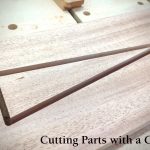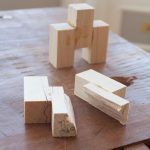We may receive a commission when you use our affiliate links. However, this does not impact our recommendations.
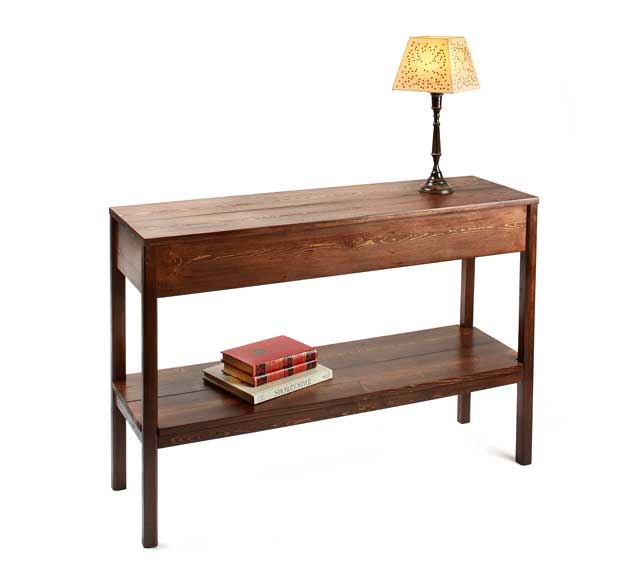 This slender table maximizes minimal space.
This slender table maximizes minimal space.
by Rodney Wilson
My family recently left our sprawling farmhouse for a compact ranch. We left our farmhouse-sized stuff too, and now we need new furniture. This little console table, under 4′ wide and just more than 1′ deep, fits nicely below a wall-mounted TV to maximize floor space, and the removable shelf provides valuable storage space.
Stock Prep
Four 47″-long pieces make the top and shelf. I bought two 1x8s, which is just enough but leaves little room for cutting off checks and cracks – consider buying a longer piece (but 8′ is max for many vehicles). You’ll also need two 6′ 1×6 boards for the side, front and back aprons, as well as two 6′-long 2x6s.
To make the legs, crosscut one 2×6 to two lengths of 31-1⁄4″ on the miter saw. Set a combination
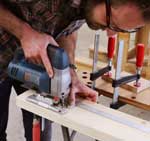
Leg rip. Use a straightedge as a saw guide and rip four 1 1/2″-square legs from the 2X6s.
square at 1-1⁄2″ and mark a line on the long edge. Align your jigsaw blade (or circular saw blade) to your mark, then align and clamp a straightedge with the edge of the saw’s shoe. Rip four legs.
When the legs are ripped to width, bundle them together to decide on and mark your final leg orientation.
Next, cut two long aprons from the 1×6 boards. Set a stop at 44″ at the miter saw and chop both pieces to length. Cut the remaining 2×6 for the long stretchers to that same length.
Reset the stop to 11-1⁄2″ and cut two short aprons from the remaining 1×6. Cut a 2×6 piece to the same length for the short stretchers.
To determine pocket-hole placement, measure and mark the center and 3⁄4″ in from both edges on the inside of your apron faces. Drill three pocket holes on each end.
Now drill a line of pocket holes along the top inside edge of each apron: two on the short aprons, three on the long aprons. Ream the holes (wiggle the bit slightly up and down in long ones, side to side in short ones) to allow for seasonal movement of the top.
Rip the shelf stretchers to 1-1⁄4″.
Finish-sand everything to #180 grit. It’s easier to do now than after assembly.
Assemble Aprons & Chamfer
Using a combination square set to 1⁄4″, mark a line, parallel to three edges, on both sides of each of your four legs for chamfers (small bevels). Leave the inside edges square.
The aprons are inset 1⁄4″ on the legs, aligned with the chamfers. The inset presents a challenge in holding the aprons in the correct position for assembly, but here’s a simple solution.
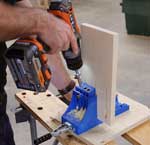
Pocket power. Carry marks up to over the jig top, then drill pockets at your apron ends.
Start by assembling the end pieces. Clamp a leg in your Workmate, leaving enough of it above the bench to secure F-style clamps to your workpieces.
Find a 1⁄4″ thick scrap and cut two lengths for “keys.” Put a scrap on each apron side and clamp to the leg face.
Drive screws into the pocket holes to secure it to the leg, then screw the second leg to that assembly. Do the same on the other end assembly.
Grab your long aprons (and a helper – this part gets a little tricky with just two hands) and attach them to the end assemblies.
Now chamfer the legs (you can do that before assembly, but it makes clamping them in place more difficult). Use a block plane to chamfer to your 1⁄4″ pencil marks. You may, like me, end up working
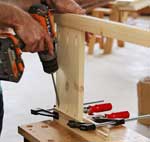
Keyed up. Clamp the 1/4″-thick scrap “keys” on either side of the aprons as you secure the, to the legs – these align the aprons with the layout for 1/4″ chamfers.
on the floor for a few of these angles – limber up first. The block plane won’t allow a full 1⁄4″ chamfer near the aprons, so chisel or sand to remove what the plane can’t reach.
Stretchers & Top
Determine your stretcher placement (I went with 10″ from the bottom), and cut a scrap piece to this measurement. Use this to lay out your stretcher locations on all four legs.
I secured the stretchers using a pocket hole on each end’s bottom and inside edge. Remember to set your pocket-hole jig and bit for the proper thickness. Drill the holes, align the stretchers to your marks and secure them using appropriate screws (2″ for the inside face, 2-1⁄2″ for the bottom).
Choose the best-looking 1×8 for the top and lay it lengthwise on the base. Flush one end to a leg face, then mark the other end. That’s the length of the top and shelf. Set a stop to this measurement and cut the two top pieces. Secure them to the apron through the pocket holes you made earlier.
Now cut the two shelf pieces to length, flush the ends and screw three scrap battens across the underside – one at each end, one at the center (ream these holes side to side too). Use a combination square to lay out the square notches at the corners, then cut them with a jigsaw. The shelf rests securely on the stretchers and is removable.
I chose a gel stain (it blotches less on pine) and topcoated with wipe-on polyurethane. Paint may look better but, after years painting barns and fences, I really wanted to see the grain.
Download the PDF of this article for the drawing and cutlist:
Contemporary Console Table
Plan: Download a free SketchUp model for the “Contemporary Console Table.”
Articles: All the “I Can Do That” articles are free online.
From the November 2016 issue, #228
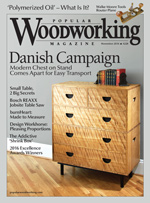
Here are some supplies and tools we find essential in our everyday work around the shop. We may receive a commission from sales referred by our links; however, we have carefully selected these products for their usefulness and quality.







